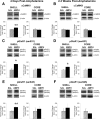Transient overexpression of alpha-Ca2+/calmodulin-dependent protein kinase II in the nucleus accumbens shell enhances behavioral responding to amphetamine
- PMID: 20089902
- PMCID: PMC2825054
- DOI: 10.1523/JNEUROSCI.4383-09.2010
Transient overexpression of alpha-Ca2+/calmodulin-dependent protein kinase II in the nucleus accumbens shell enhances behavioral responding to amphetamine
Abstract
Ca(2+)/calmodulin-dependent protein kinase II (CaMKII) is known to contribute to the expression of psychostimulant sensitization by regulating dopamine (DA) overflow from DA neuron terminals in the nucleus accumbens (NAcc). The present experiments explored the contribution of CaMKII in NAcc neurons postsynaptic to these terminals where it is known to participate in a number of signaling pathways that regulate responding to psychostimulant drugs. Exposure to amphetamine transiently increased alphaCaMKII levels in the shell but not the core of the NAcc. Thus, HSV (herpes simplex viral) vectors were used to transiently overexpress alphaCaMKII in NAcc neurons in drug-naive rats, and behavioral responding to amphetamine was assessed. Transiently overexpressing alphaCaMKII in the NAcc shell led to long-lasting enhancement of amphetamine-induced locomotion and self-administration manifested when alphaCaMKII levels were elevated and persisting long after they had returned to baseline. Enhanced locomotion was not observed after infection in the NAcc core or sites adjacent to the NAcc. Transient elevation of NAcc shell alphaCaMKII levels also enhanced locomotor responding to NAcc AMPA and increased phosphorylation levels of GluR1 (Ser831), a CaMKII site, both soon and long after infection. Similar increases in pGluR1 (Ser831) were observed both soon and long after exposure to amphetamine. These results indicate that the transient increase in alphaCaMKII observed in neurons of the NAcc shell after viral-mediated gene transfer and likely exposure to amphetamine leads to neuroadaptations in AMPA receptor signaling in this site that may contribute to the long-lasting maintenance of behavioral and incentive sensitization by psychostimulant drugs like amphetamine.
Figures






References
-
- Anderson SM, Famous KR, Sadri-Vakili G, Kumaresan V, Schmidt HD, Bass CE, Terwilliger EF, Cha JH, Pierce RC. CaMKII: a biochemical bridge linking accumbens dopamine and glutamate systems in cocaine seeking. Nat Neurosci. 2008;11:344–353. - PubMed
-
- Bell K, Duffy P, Kalivas PW. Context-specific enhancement of glutamate transmission by cocaine. Neuropsychopharmacology. 2000;23:335–344. - PubMed
-
- Benavides DR, Bibb JA. Role of cdk5 in drug abuse and plasticity. Ann N Y Acad Sci. 2004;1025:335–344. - PubMed
-
- Bennett MK, Erondu NE, Kennedy MB. Purification and characterization of a calcium/calmodulin-dependent protein kinase that is highly concentrated in brain. J Biol Chem. 1983;258:12735–12744. - PubMed
-
- Bibb JA, Chen J, Taylor JR, Svenningsson P, Nishi A, Snyder GL, Yan Z, Sagawa ZK, Ouimet CC, Nairn AC, Nestler EJ, Greengard P. Effects of chronic exposure to cocaine are regulated by the neuronal protein cdk5. Nature. 2001;410:376–380. - PubMed
Publication types
MeSH terms
Substances
Grants and funding
LinkOut - more resources
Full Text Sources
Molecular Biology Databases
Miscellaneous
